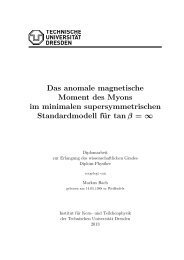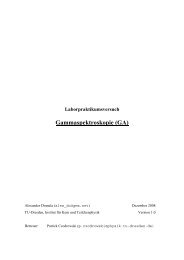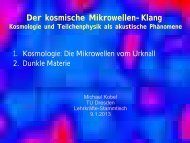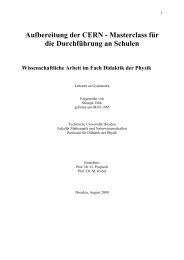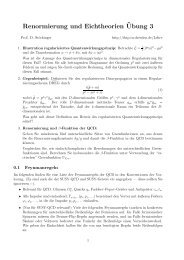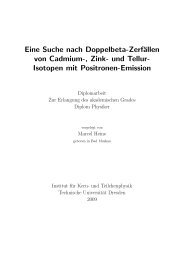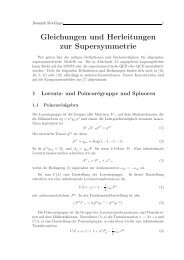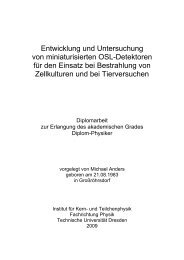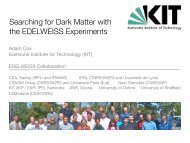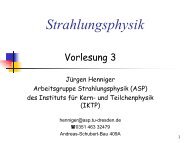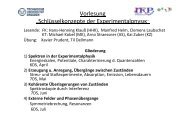a design study for a cobra upgrade to - Institut für Kern- und ...
a design study for a cobra upgrade to - Institut für Kern- und ...
a design study for a cobra upgrade to - Institut für Kern- und ...
You also want an ePaper? Increase the reach of your titles
YUMPU automatically turns print PDFs into web optimized ePapers that Google loves.
34 4 Scintillation detec<strong>to</strong>rs<br />
describe the quenching effect, the ”Birks <strong>for</strong>mula” [29]<br />
dL/dx =<br />
S · dE/dx<br />
. (4.4)<br />
1 + kB · dE/dx<br />
He introduced the quenching fac<strong>to</strong>r k and BdE/dx, which describes<br />
the density of excitation centres along the track. kB is also referred <strong>to</strong><br />
as the Birks fac<strong>to</strong>r. Likewise the α/β-ratio is quoted, which is related <strong>to</strong><br />
the Birks fac<strong>to</strong>r as long as the Birks <strong>for</strong>mula is valid <strong>for</strong> this scintilla<strong>to</strong>r.<br />
It is the ratio of the light yield <strong>for</strong> α particles <strong>to</strong> the light yield <strong>for</strong> electrons<br />
of the same energy.<br />
The quenching fac<strong>to</strong>r and α/β-ratio depend on the crystal and the conditions<br />
of the experiment. For doped materials the strength of quenching<br />
is related <strong>to</strong> the amount and kind of dopant.<br />
The α/β ratio is 0.66 - 0.67 <strong>for</strong> NaI:Tl and CsI:Tl and 0.2 <strong>for</strong> BGO. The<br />
light output of inorganic scintilla<strong>to</strong>rs depends generally less on the particle<br />
energy than the light output of organic scintilla<strong>to</strong>rs, which can<br />
have quenching fac<strong>to</strong>rs of 10 [27, 28, 29].<br />
Figure 4.6: Quenching fac<strong>to</strong>rs <strong>for</strong> α-particles in CsI:Tl and calculated<br />
quenching curve with kB = 2.3 · 10 −3 gMeV −1 cm −2 <strong>for</strong> ∆t = 5 µs [31]<br />
The time ∆t of the scintillation signal collection also determines the<br />
measured quenching fac<strong>to</strong>rs. The amplitudes of different scintillation<br />
light components depend on dE/dx. As these components have<br />
often different decay times, different fractions of these components<br />
are collected in different ∆t. For α particles in CsI(Tl) with energies<br />
between ≈ 0 and 10 MeV the Birks fac<strong>to</strong>r was determined <strong>to</strong> be<br />
1.1×10 −3 gMeV −1 cm −2 <strong>for</strong> ∆t = 1µs and <strong>to</strong> 2.3·10 −3 gMeV −1 cm −2 <strong>for</strong>





